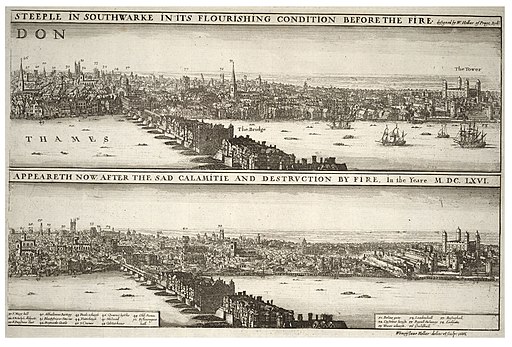The Great Fire of London wiped out three quarters of the City in 1666. It started in a bakery in Pudding Lane around midnight on Sunday 2 November. The site is marked by the famous Monument – a tall stone column with a golden representation of the fire at its peak. The fire raged until Thursday when it was finally extinguished. Much was lost. This blog about the Lost City of London is a great source for those who want to get a feel for that the city was like before the conflagration.
When the Great Fire burnt most of the City to the ground, there was a chance to impose some top down order to London’s streets. Sir Christopher Wren drew up a grand new plan with wide roads, straight avenues, circular piazzas, grand terraces and other logical focal points. This plan was never built. The city organically regrew into its original state before the plan had a chance to be implemented. It is almost as if the DNA of the medieval City reasserted itself, much as weeds sprout in vacant lots. Nature abhors a vacuum. London is as it is because that is how nature intends it to be.
But Wren did leave his mark on the City – in the 51 churches that he rebuilt and in the glorious cathedral of St Paul’s. So when you walk in the City, you walk in his presence. His churches are the tent pegs of history. They pin London to its past and anchoring the thrusting skyscrapers like guy ropes. Even the shapes of those glass and steel monoliths have been sculpted and whittled by Wren’s influence. There are legally established sight lines that guarantee a view of St Pauls from certain vantage points. That’s why the Scalpel and the Cheesegrater lean back from each other to form a victory “V” with St. Paul’s right in the centre.

The Great Fire was commemorated in 2016 by an Arts festival called “London’s Burning” . It culminated in the torching of a huge 120 meter scale model of the city before the fire that was built on a barge as shown in the photo above. You can see a video of the event here
Below you can see ( broken in to two parts) a panorama of London by Hollar showing what London looked like before the Great Fire and what it looked like after.



Pingback: Martin Benet and the Black Friar - Lost London Churches Project
Pingback: Taking The Michael - Lost London Churches Project